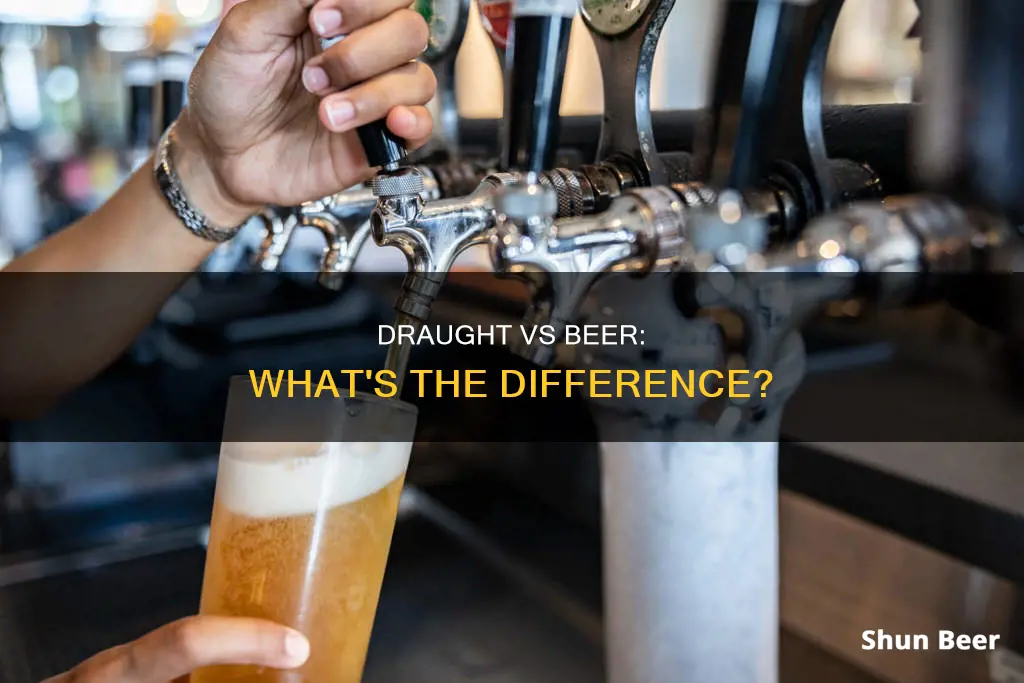
Beer is a beloved beverage worldwide, and one of the most popular ways to enjoy it is on draught or draft. But what exactly is the difference between draught and beer? In essence, they are different spellings of the same word, with draught used in the UK, Ireland, Australia, and New Zealand, while draft is more common in North America. Draught or draft beer refers to beer served straight from a keg or cask without pasteurization or filtration, providing a fresh taste and a smooth, frothy head. It offers a unique drinking experience with a diverse range of flavours and styles, from crisp lagers to robust stouts.
| Characteristics | Values |
|---|---|
| Spelling | "Draught" is used in the UK, Ireland, Australia, and New Zealand. "Draft" is used in North America. |
| Pronunciation | /drɑːft/ or /dræft/ depending on the region of the speaker. |
| Serving Method | Stored in kegs or casks and served straight from the tap. |
| Pasteurisation | Draught beer is typically unpasteurised, but some keg beers are pasteurised. |
| Filtration | Draught beer is typically unfiltered, but keg beers are filtered. |
| Storage Temperature | Draught beer stored in a traditional cask must be stored and served at a cellar temperature of 12 °C (54 °F). Keg beer is served at 3 to 8 °C (37 to 46 °F). |
| Marketing Term | "Draft" and "draught" are used as marketing terms for canned or bottled beers, implying they taste like cask or keg beer. |
What You'll Learn

Draught beer is served from a cask or keg
Serving beer straight from a cask or keg is what makes draught beer unique. This is in contrast to bottled or canned beer, which undergoes additional processing and is not considered "draught" in the purest sense, even if some brands use this as a marketing tactic.
Draught beer is served straight from a tap, which can be pressurised or pumped by hand. The tap is attached to the keg's valve, allowing the beer to flow freely. Regulating the CO2 pressure is crucial to maintaining the proper carbonation level and preventing the beer from becoming flat.
The keg blocks sunlight, preventing degradation, and it also prevents oxygen from seeping in, keeping the beer fresh for longer. In addition, draught beer is usually consumed at a faster rate, which means it is stored for less time.
Keg beer is often filtered and/or pasteurised, which renders the yeast inactive and is a process that is not usually done with draught beer. The pasteurisation process was introduced in the United Kingdom in 1936 but did not become popular until the late 1950s. It is worth noting that the usual spelling is "draught" in the United Kingdom, Ireland, Australia, and New Zealand and "draft" in North America, although it can be spelt either way.
Explore Beer Diversity: Styles, Tastes, and Brewing Secrets
You may want to see also

'Draught' comes from Old English 'dragan', meaning 'carry' or 'pull'
The word "draught" in "draught beer" comes from the Old English word "dragan", which means "to carry or pull". The word "draught" itself refers to the act of serving or drinking beer, and it is interesting to note that the use of the term became established around the time that Joseph Bramah's beer pumps were gaining popularity. The word eventually became restricted to specifically refer to beer served in this manner.
The Old English word "dragan" also developed into other related words such as "drag", "draw", and "draught". The term "draught" is now commonly used to refer to beer served from a cask or keg, rather than from a bottle or can. This method of serving beer is considered to provide a superior experience due to the preservation of freshness and flavour.
The spelling of the word varies depending on the region. In the United Kingdom, Ireland, Australia, and New Zealand, the spelling is typically "draught", while in North America, it is more commonly spelled "draft". However, both spellings can be used interchangeably, and the pronunciation may vary depending on the region.
The use of the terms "draft" and "draught" by commercial brewers as marketing terms for canned or bottled beers has been a source of confusion for consumers. While these terms imply that the beer has the taste and appearance of beer served from a cask or keg, it is technically incorrect to use the term "draught" for any beer that is not drawn from a cask or keg.
EBC Beer Shipping: State-by-State Availability and Restrictions
You may want to see also

'Draft' is commonly used in American English, 'draught' in British English
The terms "draft" and "draught" are used to refer to beer served from a cask or keg, rather than from a bottle or can. While the two terms are different spellings of the same word, the preferred variation depends on the region.
"Draft" is commonly used in American English, while "draught" is the usual spelling in British English, as well as in Ireland, Australia, and New Zealand. The difference in spellings can be attributed to the Old English "dragan", which means "to carry or pull". The term "draught" also has a series of related words, including "drag" and "draw".
Despite the regional variations, both "draft" and "draught" are pronounced either as /drɑːft/ or /dræft/, depending on the speaker's region.
While "draft" and "draught" refer to beer served from a cask or keg, companies also use these terms as marketing tools to describe canned or bottled beers. Using these terms as a marketing tactic implies that the beer tastes and appears like beer served from a cask or keg. However, it is incorrect to label any beer not drawn from a cask or keg as "draught".
Understanding Beer Strength: 3.2% vs Regular
You may want to see also

Draught beer is stored in kegs, served straight from the tap
Draught beer, also spelt 'draft', is stored in kegs and served straight from the tap. The tap can be pressurised or pumped by hand. The word 'draught' originates from the Old English word 'dragan', meaning 'to carry or pull'.
Draught beer is stored in kegs, which block sunlight from degrading the beer and prevent oxygen from seeping in, keeping the beer fresh for longer. Draught beer is usually consumed at a faster rate, which means it is stored for less time and kept fresh.
Kegs are large canisters of liquid, so they need to be cooled down to the optimal temperature before serving. The beer is then dispensed into a glass through a tap system, ensuring a smooth and frothy pour.
The process of serving draught beer begins with tapping the keg, which involves attaching a tap to the keg's valve. This allows the beer to flow freely from the keg to the tap system. Regulating the CO2 pressure is crucial to maintaining the proper carbonation level and preventing the beer from becoming flat.
In terms of storage, maintaining the proper conditions is essential. Temperature control is vital to preserving the beer's flavour and preventing it from spoiling. Kegs should be stored in relaxed environments to avoid exposure to heat, which can cause the beer to become stale.
Lager vs Beer: What's the Difference?
You may want to see also

Draught beer is considered the freshest option
Draught beer, also spelled "draft", is considered the freshest option for beer lovers. This is due to a combination of factors, including the brewing process, storage, and dispensing.
Firstly, draught beer is stored in kegs or casks, which block sunlight and prevent oxygen from seeping in, thus maintaining the beer's freshness for longer. The kegs or casks are also typically stored in relaxed, temperature-controlled environments, ensuring the beer does not become stale or spoil.
Secondly, draught beer is usually consumed at a faster rate, as it is served straight from the tap. This means that the beer is stored for a shorter period, further preserving its freshness. The tap can be pressurised or pumped by hand, with the latter being the traditional method, dating back to the invention of the beer engine in 1785.
Thirdly, draught beer often skips the steps of pasteurisation and filtration, which allows it to retain more of its natural flavours. This gives it a distinct taste that beer enthusiasts appreciate.
In summary, draught beer is considered the freshest option due to its optimal storage conditions, rapid consumption, and lack of pasteurisation or filtration, resulting in a crisp, cold, and smooth beverage with a pleasant foamy head.
Hard Cider vs Beer: What's the Difference?
You may want to see also
Frequently asked questions
Draught beer is beer served from a cask or keg, usually straight from the tap. The tap can be pressurised or pumped by hand.
Unlike bottled or canned beer, draught beer is served directly from the cask or keg, preserving its freshness and flavour. Draught beer also has a smoother texture and a frothy head.
"Draft" and "draught" are different spellings of the same word. "Draft" is commonly used in American English, while "draught" is used in British English.
Draught beer generally tastes better than bottled beer due to a combination of factors such as the brewing process, storage, and dispensing. The keg blocks sunlight, preventing degradation from light, and it also prevents oxygen from seeping in, keeping the beer fresh for longer.







